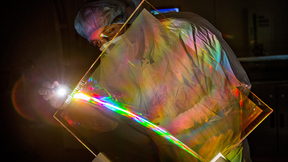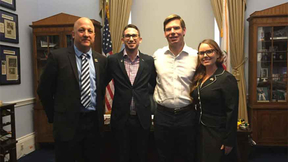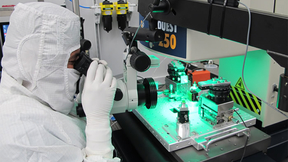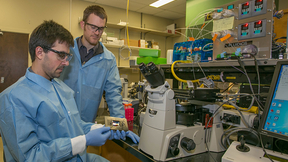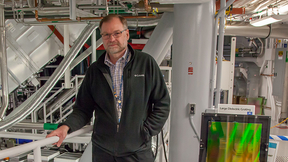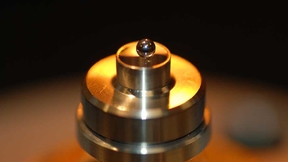Back
A new anti-reflective coating and a novel chemical process for laser optics, developed by Lawrence Livermore National Laboratory (LLNL) researchers, represents an important breakthrough in its effort to boost the energy of the National Ignition Facility’s (NIF) 192 giant lasers, and cut the cost of repairing or replacing damaged optics vital to its operation. The coating…
U.S. Marine veteran Destiny Goddu has spent her whole life working with machines. As a young girl growing up in Livermore, she helped her father, a mechanic, disassemble and rebuild car engines and tinkered with auto parts in the family garage. After joining the Marines, she worked on missile guidance systems, and as a Lab employee, hired part-time through the award…
Considering that nothing precious comes from an online retailer without protective padding, could precision laser targets also benefit from similar high-tech swaddling? So far the answer is yes, for a group of scientists developing new target technologies for NIF that are intended to neutralize what they believe is one of the bigger challenges to achieving ignition. The…
While multitasking may be easy for some people (and perhaps hard for others), it can be a particular challenge for the highly specialized equipment used to carry out experiments on the National Ignition Facility (NIF). But TanDM, NIF’s new Target and Diagnostic Manipulator, is designed to do just that. To date, it is proving itself more than up to the job of performing as…
For three Lab engineers, a Lawrence Livermore National Laboratory (LLNL) commercialization fund has proven to be an oasis of assistance as they have sought to cross the legendary technology "valley of death."In technology transfer circles, there is a phase -- between when a technology is promising and when it moves forward into commercialization -- known as the "valley of…
The High-Repetition-Rate Advanced Petawatt Laser System (HAPLS), being developed at Lawrence Livermore National Laboratory (LLNL), recently completed a significant milestone: demonstration of continuous operation of an all diode-pumped, high-energy femtosecond petawatt laser system. With completion of this milestone, the system is ready for delivery and integration at the…
Using compact lasers, a team including Lawrence Livermore National Laboratory (LLNL) scientists has created pressures more than a billion atmospheres, equivalent to the pressure in the center of a star.These conditions of extreme pressure and energy density have previously been created in the laboratory only with the world's largest lasers, which are the size of stadiums…
The Fusion Power Associates (FPA) Board of Directors has selected NIF Scientific Diagnostic Leader Joe Kilkenny to receive a 2016 Leadership Award. The award was presented at the FPA’s 37th Annual Meeting and Symposium on “Fusion Power: An International Venture,” held recently in Washington, D.C.Kilkenny was cited for “the leadership provided for inertial confinement…
Chris Barty, chief technology officer in Lawrence Livermore National Laboratory’s (LLNL) NIF & Photon Science Directorate, has been named a 2017 fellow of the Institute of Electrical and Electronics Engineers (IEEE) for his contributions to ultrahigh-intensity lasers and the advancement of X-ray and gamma-ray science. The IEEE grade of fellow is conferred by the IEEE…
More than 3.4 billion people are connected to the Internet, placing ever-increasing demand on the telecom industry to provide bigger, better and faster bandwidth to users. Lawrence Livermore National Laboratory (LLNL) researchers have taken an important step in addressing that need by developing a new type of optical fiber amplifier that could potentially double the…
Lawrence Livermore National Laboratory physicist Manyalibo (Ibo) Matthews has been elected as a fellow of the Optical Society (OSA). He was recognized by OSA for his "outstanding contributions and sustained leadership in the field of high-power laser-induced damage science, laser-material interactions and processing and vibrational spectroscopy-based materials…
Lawrence Livermore National Laboratory researchers have garnered three awards among the top 100 industrial inventions worldwide for 2016. The trade journal R&D Magazine announced the winners of its annual awards, sometimes called the "Oscars of invention," Thursday at the Gaylord Convention Center in Washington, D.C. With this year’s results, the Laboratory has now…
Advanced 3D printing promises to redefine manufacturing in critical industries such as aerospace, transportation and defense, and now, Lawrence Livermore National Laboratory is exploring the use of 3D printing to achieve unprecedented flexibility in producing "on-demand" targets for testing how materials behave under extreme conditions. Through an additive manufacturing…
In just under the time it would take to fly around the world two times -- 85 hours -- Justin Galbraith ran and hiked more than 200 miles to cross the finish line of the Tahoe 200 Endurance Run. Fighting blisters on every toe, temperatures ranging from the 40s to the 80s and sleeping only three hours, Galbraith completed the course that follows the Tahoe Rim Trail and has…
LIVERMORE, California – On Sept. 18, the National Ignition Facility (NIF) performed its 400th experiment of fiscal year (FY) 2016, meeting the year's goal several weeks early. In comparison, the facility completed 356 experiments in FY15 and 191 experiments in FY14. NIF is on track to complete 415 experiments by the end of the fiscal year, more than doubling its FY14…
U.S. Army Capt. Drake Brewster sees his academic studies and Lab research of today preparing him for his career of tomorrow. A seven-year Army officer who is pursuing a career as a nuclear counterproliferation officer, Brewster is studying for his master’s degree in physics from the Monterey, California-based Naval Postgraduate School (NPS). As part of his studies,…
When the renowned cosmologist Carl Sagan declared that "we are made of starstuff," he wasn’t speaking metaphorically. As Sagan said in the TV series "Cosmos," many of the elements in our bodies - "the nitrogen in our DNA, the calcium in our teeth, the iron in our blood" - were forged in the interiors of stars, in a process called stellar nucleosynthesis (element formation)…
A new diagnostic built on the National Ignition Facility's (NIF) roof is giving researchers a clearer picture of the neutrons released during laser-driven implosions of target capsules containing deuterium or deuterium and tritium (DT).Instruments inside the North Pole neutron Time of Flight (nTOF) enclosure, a structure slightly larger than an industrial shipping…
The Department of Energy on Tuesday named two Lawrence Livermore National Lab scientists among the winners of the prestigious DOE Office of Science’s Early Career Research Program (ECRP) awards, granting them up to $500,000 per year for five years.Félicie Albert, an experimental plasma physicist at the National Ignition Facility and expert in ultrafast X-ray sources and…
The Earth is under constant bombardment by subatomic particles called cosmic rays, including some, known as ultra-high-energy cosmic rays, which pack much more punch than the world’s most powerful particle accelerators. Fortunately, Earth’s atmosphere protects us by dissipating most of that energy before it reaches the ground.But where do these ultrafast cosmic rays come…

